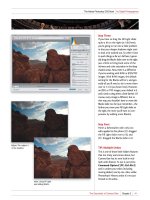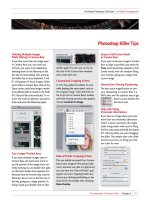Photoshop Cs5 Digital classroom split
Bạn đang xem bản rút gọn của tài liệu. Xem và tải ngay bản đầy đủ của tài liệu tại đây (2.38 MB, 35 trang )
296
Creating a composition using Smart Objects
Adobe Photoshop CS5 Digital Classroom
10
Modifying a Smart Filter
Once you add a Smart Filter, you can go back and modify the e ect, even if you’ve added a
mask, as in this case.
1 In the Butter y 4 layer, double-click on the Motion Blur e ect; the Motion Blur
dialog box appears. You may have to click and drag down and to the left inside the lter
preview window to see the image. Change the angle to 87 degrees by clicking and
dragging the dial to the right. Press OK when you are done.
Changing the angle of the motion blur now requires you to go back with the paintbrush
and modify the mask.
2 Click on the layer mask thumbnail to the left of Smart Filters to activate it. Then begin
to paint from the top do
wn, leaving just a blur at the bottom of the butter y. If you mask
out too much of the e ect, you can press X to switch to white as the foreground color
to restore the e ect in the desired areas.
3 Click on the eye icon (
) next to the Smart Filter mask. This turns the mask o
completely, and can help identify areas a ected by a lter that you may have missed.
Click to turn the mask back on and clean up any areas where you don’t want the
lter applied.
Turn o the e ects of the mask by selecting
the eye icon.
4 In the Layers panel, click on the eye icon to the left of the Visit the Rainforests type
layer on the top. Select the Move tool, and then click and drag to reposition the layers
as needed.
PSCS5.indb 296PSCS5.indb 296 4/8/2010 5:14:16 PM4/8/2010 5:14:16 PM
Self study
297Lesson 10, Getting Smart in Photoshop
10
5 Choose File > Save. Congratulations! You have nished this part of the lesson.
The completed lesson le.
Self study
In this section, you can complete some exercises on your own. Use adjustment layers to adjust
the brightness, contrast, hue, and saturation of the lesson les.
Currently, the individual butter y and bird images do not blend as well into the background
as they could. Using the techniques laid out in “Editing the contents of a Smart Object,” add
adjustment layers to the objects in the photo-illustration, and ne-tune the appearance of the
individual objects. Try to make the individual layers match each other as much as possible to
create a cohesive photo illustration.
Creating multiple Smart Objects
In this lesson, you learned how to work with Smart Objects in their various forms. Create
additional copies of the butter y or bird images, and experiment with creating a collage.
Apply lters to your existing Smart Objects. For di erent e ects, try applying a black-to-white
gradient on a Smart Filter mask to achieve a smooth transition that would be di cult to achieve
using just the Brush tool alone.
Working with Illustrator les
If you have Adobe Illustrator, you can also place .ai les into Photoshop les as Smart Object
layers. They work in similar ways. Create an image in Illustrator, and place it into Photoshop.
Create multiple copies of the Illustrator layer, and then modify the original .ai le to see the
changes applied to the layers in the Photoshop le.
PSCS5.indb 297PSCS5.indb 297 4/8/2010 5:14:16 PM4/8/2010 5:14:16 PM
298
Review
Adobe Photoshop CS5 Digital Classroom
10
Review
Questions
1 What are three ways that you can create a Smart Object layer?
2 Why would you convert a standard layer to a Smart Object layer?
3 How do you replace the contents of a Smart Object layer? When would you do so?
4 What are Smart Filters, and what are the bene ts of using them?
Answers
1 You can bring an image into an existing le as a Smart Object by choosing File > Open
as Smart Object and selecting the le, choosing File > Place, or, when using Adobe
Bridge, selecting the le and choosing File > Place > Into Photoshop. If an image is
currently inside a document and you would like to convert it to a Smart Object, select
the layer in the Layers panel and choose Layer > Smart Objects > Convert to Smart
Objects.
2 A Smart Object layer can be resized inde nitely without losing r
esolution due to
r
esampling.
3 You can replace the contents of a Smart Object layer by choosing Layer > Smart
Objects > Replace Contents.
You might use this technique if you wanted to replace one
image with another without losing any scaling, rotating or warping you had created for
the image.
4 Any lter applied to a Smart Object is a Smar
t Filter. Smart Filters appear in the Layers
panel below the Smart Object layer to which they are applied. Because you can adjust,
remove, or hide Smart Filters, they are non-destructive.
PSCS5.indb 298PSCS5.indb 298 4/8/2010 5:14:17 PM4/8/2010 5:14:17 PM
299Lesson 11, Using Adobe Photoshop Filters
What you’ll learn
in this lesson:
•
Working with filters
•
Fading filter effects
•
Using the Filter Gallery
•
Taking advantage of
Smart Filters
•
Using Vanishing Point
Using Adobe
Photoshop Filters
Filters allow you to apply artistic e ects to your images. You can
make images look as though they were sketched with chalk, drawn
with a graphic pen, or even add perspective to them. In this lesson,
you will learn how to use lters to apply interesting e ects to
your images.
Starting up
Before starting, make sure that your tools and panels are consistent by resetting your preferences.
See “Resetting Adobe Photoshop CS5 preferences” on page 3.
You will work with several les from the ps11lessons folder in this lesson. Make sure that you
have loaded the pslessons folder onto your hard drive from the supplied DVD. See “Loading
lesson les” on page 5.
See Lesson 11 in action!
Use the accompanying video to gain a better understanding of how to use some of the features
shown in this lesson. The video tutorial for this lesson can be found on the included DVD.
11
Lesson 11
PSCS5.indb 299PSCS5.indb 299 4/8/2010 5:14:17 PM4/8/2010 5:14:17 PM
300
Filter basics
Adobe Photoshop CS5 Digital Classroom
11
Filter basics
Filters are accessed using the Filter menu. When you select certain lters, the Filter Gallery
opens. Other lters, when selected, open their own dedicated dialog box. Some, like the Clouds
lter, don’t even have a dialog box.
Filters are always applied to the layer you currently have selected and cannot be applied to
Bitmap mode or indexed color images. Note that some lters, such as Brush Strokes and Sketch,
work only in the RGB mode and are not available when working in the CMYK mode.
Starting to use lters
Before starting, you may want to view the le that you are going to create.
1 Choose File > Browse in Bridge, or select the Launch Bridge ( ) or the Mini Bridge
button (
) in the Application bar, to open Adobe Bridge. Navigate to the ps11lessons
folder and open the le ps1101_done.psd.
A le including sev
eral monsters and a package design appears.
The completed lesson le.
2 You can keep this le open for reference, or choose File > Close to close it.
PSCS5.indb 300PSCS5.indb 300 4/8/2010 5:14:22 PM4/8/2010 5:14:22 PM
Starting to use filters
301Lesson 11, Using Adobe Photoshop Filters
11
Using the Clouds lter
In this lesson, you will use the Clouds lter to build a smoke-like background. The Clouds
lter generates a cloud pattern, using random values from the selected foreground and
background colors.
1 Choose File > Browse in Bridge, or select the Launch Bridge ( ) or the Mini Bridge
button (
) in the Application bar, to open Adobe Bridge. Navigate to the ps11lessons
folder and open the le ps1101.psd.
2 Choose File > Save As. In the Save As dialog box, navigate to the ps11lessons folder and
type ps1101_work
in the File name text eld. Choose Photoshop from the format
drop-down menu and click Save.
3 If the Layers panel is not visible, select Window > Layers. Click on the layer named sky
bac
kground to activate this layer.
4 Many lters in Photoshop render di er
ently, depending on your current foreground
and background colors. Press D on your keyboard to return to the default colors of black
and white.
Select the sky background layer
PSCS5.indb 301PSCS5.indb 301 4/8/2010 5:14:23 PM4/8/2010 5:14:23 PM
302
Starting to use filters
Adobe Photoshop CS5 Digital Classroom
11
5 At the bottom of the Tools panel, click the foreground color, black. The Color Picker
opens.
6 In the RGB text elds, type the v
alues, R: 55, G: 71, B: 92. Then press OK. Your
foreground color has been changed. You are now ready to apply the Clouds lter.
Enter custom values in the Color Picker.
7 Choose Filter > Render > Clouds.
A cloud pattern is generated, using random values of the foreground and
background colors. Do not save your le, continue to the next part of this lesson.
To achieve a more high-contrast e ect, press the Alt then Shift keys (Windows) or the Option key
(Mac OS) while selecting the Clouds lter.
PSCS5.indb 302PSCS5.indb 302 4/8/2010 5:14:24 PM4/8/2010 5:14:24 PM
Fading your filter
303Lesson 11, Using Adobe Photoshop Filters
11
Fading your lter
Now that you have made some clouds, you’ll fade the e ect of the Cloud lter. The Fade
command gives you the opportunity to change the opacity and blending mode of a lter e ect
immediately after you have applied it. Fade also works with the erasing, painting, and color
adjustment tools.
1 Choose Edit > Fade Clouds. The Fade dialog box appears. Check the Preview option to
preview the e ect if it is not already checked.
The Fade dialog box.
If Fade Clouds is not available, you did something else with the le after using the Clouds
lter. Use the Window > History panel to select the Clouds state, then select Edit > Fade
Clouds again.
2 Drag the slider to the left to adjust the opacity from 100 percent down to 50 percent.
Leav
e the Mode drop-down menu set to Normal, then press OK. Keep this le open for
the next part of this lesson.
Fading the e ect of the Cloud lter.
PSCS5.indb 303PSCS5.indb 303 4/8/2010 5:14:25 PM4/8/2010 5:14:25 PM
304
Using the Filter Gallery
Adobe Photoshop CS5 Digital Classroom
11
Using the Filter Gallery
The Filter Gallery allows you to apply more than one lter to an image at a time, and rearrange
the order in which the lters are applied.
Note that not all lters are available in the Filter Gallery, and that the Filter Gallery is not
available in CMYK, Lab, or Bitmap mode.
1 With ps1101_work.psd open, click the visibility icon ( ) next to the layer group named
monsters. Three monsters appear.
2 Expand the layer group by clicking on the triangle immediately to the left of the
monsters la
yer group. This displays the monster1, monster2, and monster3 layers that are
included in this group.
Click on the arrow to the left of the The individual monster layers are revealed.
monsters group.
3 Select the monster1 layer.
4 Press D on your k
eyboard to return to the default foreground and background colors of
black and white.
PSCS5.indb 304PSCS5.indb 304 4/8/2010 5:14:26 PM4/8/2010 5:14:26 PM
Using the Filter Gallery
305Lesson 11, Using Adobe Photoshop Filters
11
5 Choose Filter > Filter Gallery. The Filter Gallery dialog box appears.
6 Press Ctrl+- (minus sign) (Windows) or Command+- (minus sign) (Mac OS) four times
to zoom to 25%.
A B C
D
E
F
G
A. The Preview pane. B. Filter categories. C. Thumbnail of lter. D. Show/Hide lter thumbnails.
E. Filters drop-down menu. F. Options for the selected lter. G. List of lter e ects.
Applying lters in the Gallery
You’ll now apply several lters to create di erent versions of the monster image. When you
apply a lter from the lter categories, located in the center portion of the window, a preview
of the image with the lter applied is displayed in the Preview pane. Along the right side of the
window, options for the selected lter are displayed.
1 In the lter categories section, expand the triangle next to the Stylize folder to reveal the
Glowing Edges lter.
PSCS5.indb 305PSCS5.indb 305 4/8/2010 5:14:26 PM4/8/2010 5:14:26 PM
306
Using the Filter Gallery
Adobe Photoshop CS5 Digital Classroom
11
2 Click the Glowing Edges thumbnail to add a glow to the edges of areas with color; the
monster now has bright neon, glowing edges. Press OK to apply the lter.
The monster with the Glowing Edges lter applied.
3 To make the monster slightly transparent click and drag the Opacity slider in the Layers
panel until you reach 50%.
You’ll now apply additional lters to the other monster la
yers.
4 Select the monster2 layer in the Layers panel.
5 Choose Filter > Filter Gallery to apply a lter to this lay
er. Do not select the Filter
Gallery menu item that appears rst under the Filter menu. That is where your last-used
lter appears, and it does not allow you to change options. Choose the Filter Gallery
menu item that appears further down in the menu.
6 Click on the triangle to the left of Artistic to expand and show the artistic lters,
and
then click on the Fresco thumbnail. The Fresco lter is applied to the image in the
Preview pane.
Fresco is an Italian term for a mural painting done on a wet, freshly plastered wall. It
creates an inter
esting abstract e ect. The Fresco lter adds a good deal of black to the
image in the process of abstracting it, so you will tone it down a bit with another lter.
PSCS5.indb 306PSCS5.indb 306 4/8/2010 5:14:27 PM4/8/2010 5:14:27 PM
Using the Filter Gallery
307Lesson 11, Using Adobe Photoshop Filters
11
7 In the Fresco lter options pane make sure the Brush size is set to 2, the Brush Detail to
10, and the Texture to 1. Do not press OK, as you will add another lter.
Applying the Fresco lter e ect.
Now you’ll apply a second lter to this layer.
8 Click the New E ect Lay
er button ( ) located at the bottom of the lter e ects area.
This adds a new lter instance above the previous lter e ect. There are now two
instances of the Fresco lter applied.
9 Click the triangle to the left of Artistic to close that lter category
, and then click the
triangle to the left of Texture to expand that category.
PSCS5.indb 307PSCS5.indb 307 4/8/2010 5:14:27 PM4/8/2010 5:14:27 PM
308
Taking advantage of Smart Filters
Adobe Photoshop CS5 Digital Classroom
11
10 In the lter categories section, select Craquelure. Craquelure is a term used for the
network of ne cracks that can appear on a painting, either over the whole painting or
just in parts. You will use the Craquelure lter to add some texture to the monster.
11 In the Craquelure lter options pane use the sliders to change the Crack Spacing to 6
,
the Crack Depth to 2 and the Crack Brightness to 2. Press OK to apply the lter.
Click and drag the e ects to change the primary e ect.
12 Choose File > Save. Keep this le open.
You can add more e ect layers and experiment with di erent orders to produce new e ects. You
can also show and hide the visibility of each lter e ect by clicking on the visibility icon next to
each e ect.
Taking advantage of Smart Filters
The lters you applied in the last section were destructive, meaning that any changes you made
using these lters a ected your original image data. As you discovered in Lesson 10, “Getting
Smart in Photoshop,” Smart Filters are a non-destructive way to apply lters to an image. In this
lesson, you will practice applying lters using the Smart Filter feature.
PSCS5.indb 308PSCS5.indb 308 4/8/2010 5:14:28 PM4/8/2010 5:14:28 PM
Taking advantage of Smart Filters
309Lesson 11, Using Adobe Photoshop Filters
11
Applying a Smart Filter
1 Select the monster3 layer in the Layers panel.
2 Choose Filter > Convert for Smart Filters. A warning dialog box may appear, advising
you that the la
yer will be made into a Smart Object. Press OK.
A Smart Object icon appears in the lower-right corner of the monster 3 layer thumbnail.
This indicates that this lay
er is now converted for use with Smart Filters. Next, you will
apply some lters in the Filter Gallery, and then update and change the way the lters are
applied to the image.
The Smart Object icon on the layer thumbnail.
3 Make sure that the monster3 layer is still selected, and then choose Filter > Filter Gallery.
Make sure you do not select the Filter Gallery listed rst in the Filter menu.
Note that the last lters y
ou used are applied to the layer by default, although these can
be changed.
4 Click on Craquelure lter e ect in the list of lter e ects in the low
er-right side of the
Filter Gallery dialog box.
5 In the lter categories section,
expand the Artistic category and select Plastic Wrap. The
Plastic Wrap lter replaces the Craquelure lter.
6 Click on the Fresco lter e ect and then select the Sponge lter e ect from the
Artistic
category. The Sponge e ect replaces the Fresco e ect.
PSCS5.indb 309PSCS5.indb 309 4/8/2010 5:14:29 PM4/8/2010 5:14:29 PM









